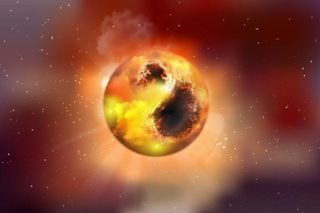Betelgeuse's dimming caused by gigantic starspots !

An artist’s illustration of the red supergiant Betelgeuse. Its surface in this view is covered by large starspots, which reduce its brightness. During their pulsations, such stars regularly release gas into their surroundings, which condenses into dust.
(Image: © Graphics Department/MPIA)
Betelgeuse is usually the tenth-brightest star in the night sky and, after Rigel, the second-brightest in the constellation of Orion. It is a distinctly reddish semiregular variable star whose apparent magnitude, varying between +0.0 and +1.6, has the widest range displayed by any first-magnitude star. At near-infrared wavelengths, Betelgeuse is the brightest star in the night sky. Its Bayer designation is α Orionis, Latinised to Alpha Orionis and abbreviated Alpha Ori or α Ori.
Classified as a red supergiant of spectral type M1-2, Betelgeuse is one of the largest stars visible to the naked eye; imagined as being at the center of the Solar System, its surface would lie beyond the asteroid belt and it would engulf the orbits of Mercury, Venus, Earth, Mars, and possibly Jupiter. Nevertheless, there are several larger red supergiants in the Milky Way, including Mu Cephei and VY Canis Majoris. Calculations of Betelgeuse’s mass range from slightly under ten to a little over twenty times that of the Sun.
During an approximately six-month period from October to April, the massive bright star Betelgeuse in the constellation Orion the Hunter dropped by 40% in brightness. Astronomers were perplexed and amateur astronomers were awe struck by the affect the change had on the appearance of the familiar winter constellation.
One of the initial leading theories was that the dimming was caused by an opaque gas or dust cloud orbiting or ejected by Betelgeuse. A rather dense region of the stuff passed between us and the star and caused the star’s brightness to diminish.
Another plausible theory has gained acceptance among astronomers at Germany’s Max Planck Institute for Astronomy this summer. According to it, large dark “star spots” on the surface of Betelgeuse rotated around to its side facing Earth. The spot or spots were so large that they reduced the effective radiance of the star in our direction.
But the new study suggests that the dimming was inherent to Betelgeuse itself. Researchers scrutinized the supergiant in January, February and March of this year using the James Clerk Maxwell Telescope (JCMT) in Hawaii, which views the cosmos in submillimeter light, a wavelength invisible to the human eye. The data suggest that Betelgeuse's dimming was associated with a drop in the mean surface temperature of around 360 degrees Fahrenheit.This is a clear indication of huge starspots covering between 50% and 70% of the visible surface, each having a lower temperature than the rest of the surface.
Starspots are temporary dark, relatively cool patches on a star's surface that feature very strong magnetic fields. Our own sun has them; astronomers have been counting sunspots for hundreds of years as a way to gauge stellar activity.
As far as Betelgeuse goes, additional observations over time will confirm whether the star spot theory of the star’s dimming will be supported.

Comments
Post a Comment